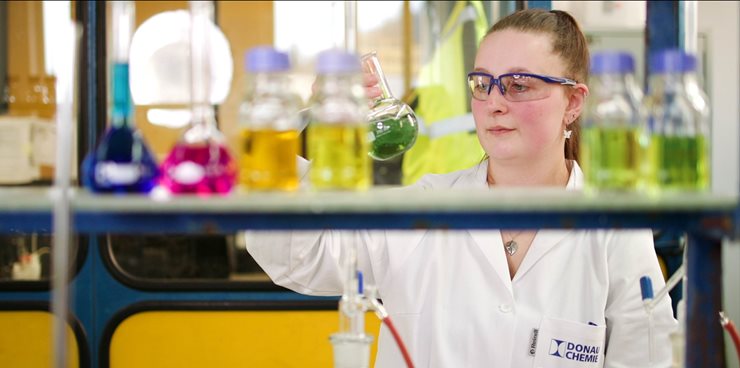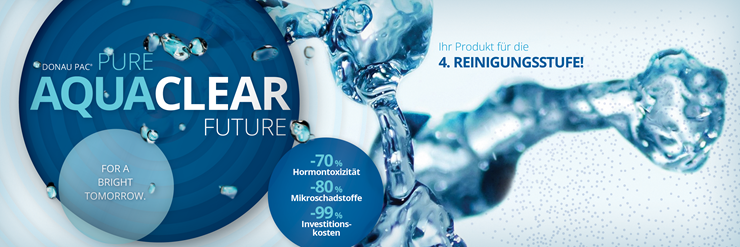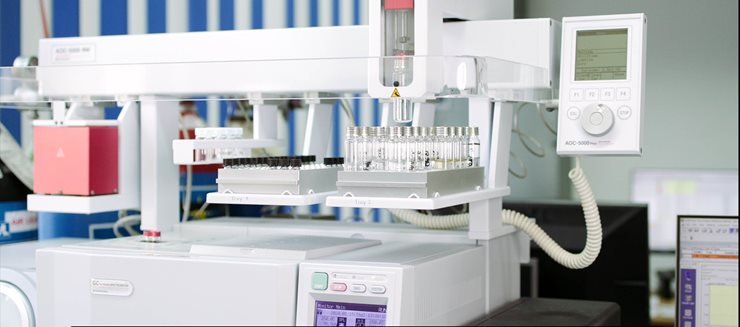Wastewater treatment is an important process for protecting the environment and guaranteeing clean water. Our wastewater undergoes three or four treatment steps. In this article, we take a closer look at the treatment steps and take a look at the future of wastewater treatment.
How does wastewater treatment work?
The process of wastewater treatment is designed to remove impurities from all types of wastewater before it is discharged back into natural water bodies. The main purpose of municipal wastewater treatment is to remove nutrients such as carbon, nitrogen and phosphorus. Industrial wastewater usually has different impurities, and therefore the goal and often the process of wastewater treatment is different.
Modern municipal wastewater treatment essentially is divided into three steps:
The 3 classic wastewater treatment steps
1. Mechanical wastewater treatment
Mechanical wastewater treatment is the first step in wastewater processing, which removes sand, hygiene products, paper, food residues, grease and other large particles. By treating the water with various methods such as screens, grit chambers or sedimentation tanks, visible and large particles are removed in this first step.
2. Biological wastewater treatment
Biological wastewater treatment is designed to remove organic contaminants such as carbohydrates, proteins and fats from sewage. Microorganisms decompose the organic pollutants in aeration tanks utilizing a constant supply of oxygen. Nitrogen compounds are converted into gaseous nitrogen through various processes such as nitrification or denitrification. Other pollutants are also metabolized and thus integrated into the bacterial mass.
Finally, the water flows into secondary clarifiers, where the bacteria gradually settle as activated sludge flocs. What remains is a biomass as sludge at the bottom of the tank, the purified water is discharged by an overflow.
3. Chemical wastewater treatment
In physico-chemical wastewater treatment, which is referred to as the third treatment step, chemical products (so-called coagulants, frequently iron(III)chlorides) are used to remove substances such as phosphates from the wastewater. At the same time, the coagulants also improve sludge flocculation and thus contribute to a successful separation of the bacteria sludge from the purified water.
Heavy metals or other harmful substances can also be removed from the wastewater through chemical-physical treatment.
Sludge treatment
The sludge that is separated in the biological step is then sent for further processing. In the simplest case, this can involve dewatering. Today, however, larger wastewater treatment plants are equipped with an anaerobic sludge treatment system. In digesters, which are usually visible from a distance, the sludge is microbiologically converted in the absence of air. During this sludge stabilisation process, some of the organic substances are converted into methane. The gas is burned on site to generate heat and electricity, significantly improving the energy balance of a wastewater treatment plant and making an important contribution to climate protection.
Sewage sludge is now considered a valuable resource rather than waste due to its high phosphorus content. It is commonly used in agriculture as a substitute for fertiliser, either directly or in the form of compost, for landscaping purposes.
The targeted removal of phosphorus from sewage sludge has received increasing attention in recent years. Phosphorus is an essential nutrient in agriculture and a critical raw material in the EU, as we are dependent on supplies from external countries. Switzerland and Germany have already made phosphorus recovery a legal requirement. The recovery of valuable materials is an important element in the European Union's sustainability strategy. In the future, sewage sludge will be increasingly regarded as a raw material at both EU and national levels.

The 4th step of wastewater treatment: Removal of micropollutants
In the future, a fourth treatment step will be required. This step generally includes all processes that go beyond existing wastewater treatment. Specifically, it is used for the further removal of micropollutants, such as pharmaceutical residues, hormonal compounds, and other substances present in very low concentrations. The fourth step is of major importance because even trace substances, present in concentrations as low as a few micrograms to nanograms per litre, can have serious effects on the ecosystem and on health.
It has only been in recent years that it has become possible to detect these substances in low concentrations within complex matrices such as wastewater. Although many of these substances are important medical agents, such as painkillers or anti-hypertensive products, and are therefore widely used, their concentration in wastewater and the way they are processed in sewage treatment systems have only been known since suitable analytical methods became available. Some active ingredients are removed during conventional wastewater treatment, while others require additional purification steps.
Processes of the fourth treatment step
The fourth treatment step involves various processes.
Ozonisation:
The wastewater undergoes ozone treatment, which is a powerful oxidising agent capable of destroying micropollutants. This process results in smaller fragments that are not well identified analytically, and little is known about their composition and hazard potential.
Activated carbon filtration:
The wastewater comes into contact with activated carbon, which removes micropollutants by accumulating them on its surface. Activated carbon can be in the form of granules or powder. Powdered activated carbon is dosed into the wastewater and then disposed of with the sludge. Granulated activated carbon is used in filters and remains in the filter until it is fully loaded with substances, at which point it is replaced with fresh carbon or reactivated externally.
DONAU PAC® AQUACLEAR is a modification of the addition of powdered activated carbon. This newly developed product combines the reliable removal of micropollutants by activated carbon with effective phosphate precipitation. This product efficiently performs both functions.

Excursus: DONAU PAC® AQUACLEAR for the 4th treatment step
There are several effective methods for removing micropollutants, such as medicines, from wastewater. One of these methods is the use of DONAU PAC® AQUACLEAR, which is exceptionally user-friendly. DONAU PAC® AQUACLEAR replaces the coagulant required in most wastewater treatment plants. Due to its unique properties and composition, it can also effectively remove micropollutants from the water.
Activated carbon is commonly used to bind pollutants due to its large surface area, which retains and encloses pollutants in small channels. However, its use requires suitable systems, which can increase complexity and support requirements.
Using a patent-pending process, we activated the carbon and combined it into a stable mixture with the coagulants already used in wastewater treatment. This innovative solution enables the replacement of a conventional coagulant with DONAU PAC® AQUACLEAR without any additional effort.
AQUACLEAR supports the removal of micropollutants and also facilitates the separation of other contaminants by fixing them into particles and then separating them.
What are the benefits of wastewater treatment?
Modern wastewater treatment is a result of devastating epidemics in the 19th and early 20th century that had a profound impact on the population of many European cities. Diseases such as cholera, which could be traced back to contaminated water, caused the deaths of thousands of people. The invention of the microscope and the discovery of microorganisms led to the understanding, despite massive resistance, that water could make people sick and that drinking water had to be treated. As drinking water was often taken from rivers or groundwater contaminated by domestic sewage, the need for wastewater treatment was recognized.
In the last century, modern biological treatment plants have been developed and optimized, allowing us in Europe to drink tap water without fear of diseases such as cholera or typhoid. Access to safe drinking water is a privilege that is not shared by many. Much of Africa, Asia and other continents still lack comprehensive drinking water treatment systems, not to mention sanitation.
The challenges of wastewater treatment
Wastewater treatment faces ongoing challenges, particularly with regards to filtering out pharmaceutical residues and other persistent substances. New processes are required to address these challenges. Additionally, sustainability targets, energy neutrality, material recovery, and new directives present exciting opportunities for the future of wastewater treatment.
The EU Water Framework Directive
The Water Framework Directive was adopted in 2000 with the intention of ensuring that future generations have access to clean water. Member states are required to take appropriate measures to guarantee or establish good ecological and chemical status of water bodies by 2015 or, with exceptions, by 2027. The key point is that there must be no deterioration in water quality. Functioning wastewater treatment is essential for fulfilling this important task.
The Urban Waste Water Treatment Directive
The Urban Wastewater Directive is the basis for modern urban wastewater treatment in the EU. It is applicable law and was published over 30 years ago. Treatment targets are based on its specifications, although some countries have also prescribed stricter requirements in national legislation.
In 2022, the European Commission proposed a revision of the directive to meet current requirements and learn from past experiences. After review and negotiations between Parliament and the Council, a revised directive was released for final vote. If approved by both the EU Council and Parliament, it will be published before the end of this legislative period.
The new regulations impose stricter requirements for wastewater treatment, including lower limit values for nitrogen and phosphorus. Additionally, more wastewater treatment plants will be required to remove phosphate, even in non-sensitive areas above a certain size. Large plants and smaller ones that discharge into sensitive water bodies will also be required to implement a fourth treatment step.

Innovative wastewater treatment with DONAU PAC® AQUACLEAR
DONAU PAC® AQUACLEAR offers a number of advantages for the user:
-
DONAU PAC® AQUACLEAR does not require any special safety precautions and can be handled like a conventional coagulant.
-
It effectively fixes micropollutants and phosphate while supporting sedimentation.
-
The effect of DONAU PAC® AQUACLEAR is reliable and robust.
-
The application is simple and uncomplicated.
-
DONAU PAC® AQUACLEAR is flexible and can be easily customized to individual requirements.
-
DONAU PAC® AQUACLEAR does not require complex adaptation of existing systems, saving time and resources.
-
DONAU PAC® AQUACLEAR does not increase the workload of support staff.
-
It is a tried-and-tested product that has already proven itself in the field.
DONAU PAC® AQUACLEAR in application
DONAU PAC® AQUACLEAR has been successfully used to treat the entire wastewater of individual sewage treatment plants. Different dosing points were selected depending on local conditions and specific test requirements.
Additional coagulants were not added during the use of DONAU PAC® AQUACLEAR. The test results support the effectiveness of AQUACLEAR.
-
The plant consistently demonstrated efficient removal of micropollutants and reliable phosphate precipitation.
-
No malfunctions or deterioration were detected during operation. In fact, the secondary clarifier even showed improved depth of visibility.
-
Purification performance was observed to improve, especially in the biological stage of the wastewater treatment plant.
-
Microscopic images revealed that the activated carbon had integrated into flocs, which is believed to be the cause of the improvement.
In the future, the EU will require the removal of several micropollutants from wastewater. Ongoing tests have already demonstrated the successful removal of these substances, making DONAU PAC® AQUACLEAR an effective product for the fourth treatment step.
Read also: Donau PAC AQUACLEAR: Successful field test for the removal of micropollutants from wastewater
Wastewater treatment: conclusion
Clean water in our water bodies, and therefore perfect drinking water, was a major achievement of the 20th century. Modern sewage treatment plants preserve our rivers and lakes as valuable ecosystems, preventing them from becoming dead bodies of water.
The three classic process stages (mechanical, biological, physico-chemical) have largely been successful in removing pollutants and, in particular, excess nutrients. However, new challenges arise for future wastewater treatment due to the presence of pharmaceutical residues, cosmetics and other micropollutants, even in very low concentrations. Traditional processes may not be sufficient to remove some of these substances. Therefore, the fourth step of wastewater treatment is becoming increasingly important.
Sewage sludge contains valuable raw materials, such as phosphorus, which will be increasingly extracted and reused in the future.
Wastewater and its components can also generate energy, achieving energy neutrality in wastewater treatment.
Solutions must be found for these and other challenges in the coming years.
Coagulants will play a key role in achieving these goals. Having a low carbon footprint themselves, they help wastewater treatment plants maintain good effluent quality, recover important raw materials such as phosphorus from wastewater, and achieve climate and energy neutrality.
Products like DONAU PAC® AQUACLEAR will support the wastewater treatment plant in the fourth step of the treatment process.
Read also: INCOPA – Life Cycle Assessment (LCA) report – IVL